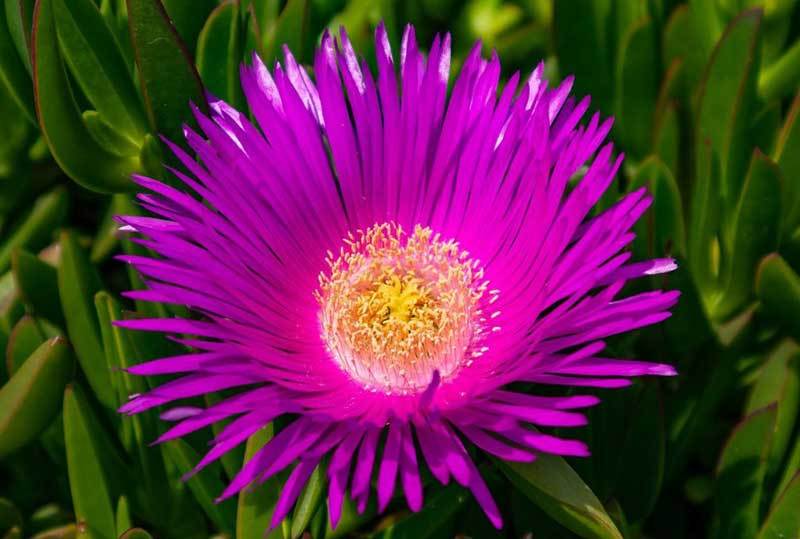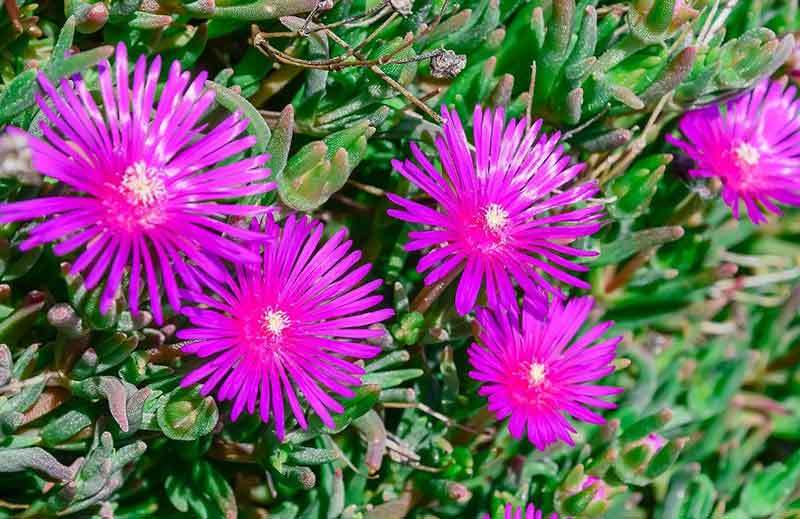The Ultimate Guide to Propagating Pigface: A Step-by-Step Tutorial
Introduction
Pigface (Carpobrotus glaucescens) is a succulent native to many parts of Australia. This low-growing groundcover is popular in gardens and landscapes for its vibrant blooms and resilience. They often last up to five years without any intervention or maintenance.
Propagating pigface can help you quickly expand your garden with an array of captivating colors. Pigface grows well from semi-hardwood cuttings, the most common method of propagation. But it can also be propagated from seeds sown in plastic seedling trays or directly into the soil. Whether you are starting a new garden bed or simply want more color in your current one, pigface is easy to propagate with either method.
In this blog post, we will go in-depth about the best methods for propagating pigface and provide tips on how to ensure your cuttings root correctly. We’ll also discuss planting depths, watering schedules and other important factors that you need to consider when growing pigface. By the end of this guide, you will be ready to propagate your own pigface with confidence! So let’s get started and learn more about this resilient succulent.
Understanding Pigface
Common varieties of pigface: Pigface (Carpobrotus spp.) is a prostrate, succulent groundcover with distinctive fleshy leaves and bright, showy flowers. There are several varieties of pigface commonly cultivated for propagation. For example, Carpobrotus edulis (hottentot fig or ice plant), C. acinaciformis (Paroo lily) and C. glaucescens (coastal pigface). Each of these has similar growth requirements and propagating processes. So farmers can easily develop their own favored variety without significant additional effort.
Climate and growing conditions: Pigface thrives in full sun and well-draining soils with medium to low water needs. Too much water will kill it. This makes it an ideal groundcover for hotter and drier climates. The succulence of the plant is an adaptive mechanism which helps it store and conserve water in its fleshy leaves and stems during dry periods. This allows pigface to survive long bouts of drought.

Methods of Propagation
Propagation pigface from seeds
1. Pigface seeds require some preparation before planting, including soaking in lukewarm water for up to 24 hours. Gently rubbing off the outer seed coat with a piece of fine sandpaper or cloth.
2. Planting pigface seeds in a container filled with moist potting soil is the best way to start them indoors. Ensure the soil remains moist. Keep the containers in an area that receives plenty of light but not direct sunlight. Germination usually occurs within 2-3 weeks under these conditions.
3. Transplanting seedlings outdoors into garden beds or plastic plant pots when they have reached at least three inches tall and have developed two sets of true leaves.
Growing pigface from cuttings
1. How to grow pigface from cuttings? Select firm, healthy stem cuttings that measure three to five inches long. Look for ones with emerged roots or new growth buds on the tips.
2. Prepare the pigface cuttings by removing any leaves from the bottom half of each cutting. Dip the ends in a rooting hormone solution before planting them in moist potting soil or water-filled containers.
3. To encourage root formation, keep cuts covered while providing bright indirect sunlight and maintain even moisture levels in the soil or water containers. Root formation generally takes about two weeks. This depends on environmental conditions.
Pigface propagation through division
1. Pigface plants are best divided in spring when new growth appears. Ensure the division is done carefully to keep as many roots intact as possible. Replant divisions into individual containers or beds.
2. Use a spade or fork to gently pry apart and separate pigface plants at their base. Then, place each portion in its own pot filled with well-draining soil.
3. Water the newly divided clumps. Keep them in light shade until they become established. Then, gradually increase sun exposure. Water frequency until full outdoor care can be provided. If you have questions related to propagating pigface plant, consult a horticulture expert for assistance.
How To Propagate Pigface?
Soil requirements for pigface propagation: Pigface is a hardy, resilient plant. It can thrive in an array of soil types. However, it does have some soil requirements for optimal growth. The ideal pH level for pigface lies between 6.0 and 7.5.
It prefers well-draining soils with good organic matter content. Or sandy loam soils with plenty of organic matter amendments such as compost, aged manure and leaf mulch. Amending your soil with these materials will help ensure your pigface has a nutrient-rich environment free from waterlogging. This is an essential element for its continued health and growth!
Choosing a planting location: When choosing the perfect spot for your propagated pigface, it’s important to consider both sunlight and climate or weather conditions. Pigface will thrive in full sun. So it should receive at least six hours of direct sunlight each day.
It can also tolerate partial shade but may not flower as profusely as in sunny spots. Additionally, choose a planting location where your pigface won’t be exposed to extreme temperatures and winds. This could cause damage to its foliage.
How to grow pigface? Propagating pigface is relatively simple and requires just a few steps. Before you begin, dig a hole twice the size of the root ball and prepare the soil for transplantation. Mix in plenty of organic materials like leaf mulch, compost and aged manure. This ensures your pigface is getting all the necessary nutrients it needs to thrive.
Plant your pigface at its existing depth and gently water it in. Mulch around the base of the plant to help keep your pigface healthy and hydrated throughout the summer months. This will also help protect it from extreme temperatures. With proper care, you’ll be rewarded with a beautiful display of pink flowers!
Nurturing and Caring for Pigface
Watering Needs: Understanding pigface’s drought-tolerant nature is an important part of caring for the plant. Although it can survive with minimal water, regular watering during its growth stages will help ensure it thrives.
During the seedling stage, pigface should be watered regularly. So that soil moisture stays constant but not oversaturated. Once established, adult plants may only need weekly or biweekly watering.
Watering techniques vary depending on region and climate. For example, in dry climates a deep soak is more beneficial than frequent light irrigation. In wetter climates, however, light and frequent sprinklings are best for keeping soils moist but not overly saturated.
Fertilizing Pigface: The right fertilizer is essential for the health and growth of a pigface plant. Most nurseries will stock fertilizers specifically designed to meet the nutritional needs of this drought-tolerant succulent.
A balanced liquid fertilizer with equal parts nitrogen, phosphorus, and potassium is usually recommended. Applied at half strength every four weeks during the growing period. In addition, slow-release fertilizers can be used in early spring before new growth begins. Simply apply according to package instructions and lightly rake into soil around plants.
Pruning and maintenance: Regular pruning helps keep your pigface plant looking its best throughout the year. Trim back any dead or damaged leaves and stems as soon as they appear. This will also encourage the plant to grow in a more compact, bushy shape.
In addition, certain pests and diseases can threaten pigface plants, so it’s important to inspect them regularly for signs of trouble. Proper maintenance such as weeding and mulching can help prevent some of these threats. You can use an appropriate insecticide or fungicide if pests do become an issue.
Overwintering pigface: Pigface is quite hardy when cold temperatures. But that doesn’t mean you should ignore winter care altogether. To prepare your plants for colder months, reduce watering and fertilizing frequency in late autumn.
Additionally, cover with frost cloth or plastic sheeting before nighttime temperatures drop below freezing. This will help protect against frost damage, should it occur. Pay attention to signs of dehydration or any other type of distress. If you detect them, take steps to remedy the issue before it becomes serious.

Troubleshooting Common Issues
Pest infestations: Pigface is prone to pests such as aphids, caterpillars and mealybugs. You can look for small insects on the foliage or signs of damage caused by them.
Act quickly at the first sign of an infestation. Use a pesticide specifically recommended for pigface. You should follow all safety instructions carefully when using pesticides. For example, wear gloves and protective clothing. Ensure that children and pets are not present while applying insecticides to your plant.
Nutrient deficiencies: You can identify them by yellowing or browning of the foliage or stunted growth. Consider adding a balanced fertilizer with nitrogen, phosphorus and potassium to the soil if your pigface plants exhibit one of these signs.
Additionally, you can use foliar feeding to provide nutrients directly to the plant leaves. Don't over-fertilize your pigface. Because this can cause sudden death of the plant.
Dealing with diseases: Pigface can suffer from several fungal and bacterial diseases such as root rot, leaf spot and powdery mildew. You can prevent these diseases from occurring. For example, ensuring there is adequate drainage and air circulation around your plant. Avoid over-watering and removing any affected foliage as soon as you notice it.
If your plants become infected, address the problem quickly by treating them. You can use a fungicide or bactericide specifically recommended for pigface. You must follow all instructions carefully to ensure the effectiveness of the treatment.
Harvesting and Utilizing Pigface
Harvesting pigface flowers and leaves:: Harvesting pigface is simple, yet rewarding. It’s best to pick the plant when it’s in flower. Because this is when its flavor is at its peak. To harvest flowers, simply collect some of the bright yellow flowers in a dry glass jar. These can be used fresh or dried for later use.
Additionally, you can harvest the fleshy succulent leaves by snipping them with scissors or pruning shears from the base of their stems before they flower. Because flowering reduces leaf production. The leaves are also edible and have a slightly salty taste reminiscent of capers or olives.
Creative uses: You can use the pigface leaves and flowers in different creative ways in cooking. Fresh flower petals make for an attractive and unique garnish on a salad or soup. Young leaves are greatly cooked in stir-fries, casseroles or added to pasta dishes.
Alternatively, they can be pickled, thrown into salsa, pesto sauce or blended into smoothies. Pigface is also traditionally eaten raw with olive oil as part of an antipasto platter.
As a natural dye source: As well as being edible, pigface has potential applications as a natural dye source too. Its yellow flowers are a great source of brilliant yellow and orange hues which can be used to dye fabrics, paper and other materials.
With some experimentation, the plant’s leaves can also be utilized as a source of green dye. This is done by boiling them in water for several hours before adding your chosen fabric or paper material into the mix. Once cooled, you can expect to get vibrant colors ranging from light greens to deep blues depending on how long you boil the leaves for.
Conclusion
Propagating pigface is a simple process that can be done through both seed and stem cuttings. Growing pigface in pots indoors several weeks prior to the last frost date. This allows you to easily transplant the seedlings after they have sprouted.
Propagating pigface cuttings are best done in late spring or early summer when new growth is available at the tips of stems. Growing pigface cuttings directly into soil provides them with greater stability when they begin developing roots. While establishing itself, pigface requires additional water and light for successful growth.


